Here’s the good news: book sales just keep growing every year, and cookbooks are a huge part of that. In fact, recipe ebook sales grew by 21% in 2017-2018.
But the bad news? Well… if you want a slice of that success pie, then you need to do the work. Traditional publishers don’t offer the in-depth marketing support that some authors expect, and if you’re a self-published chef, then you’ll be totally reliant on your own resources.
So how can you promote a cookbook on social media, without blowing your budget or burning out?
What makes your recipe book unique?
Before we dive right in, there’s one essential question to ask. Think of this section as pre-heating your oven before you start mixing up the ingredients in your social media strategy.
Because cookbooks are so popular right now, you’ll be publishing in a crowded market. And we have hard evidence that recipe books with a theme – like low carb meals, or recipes to make with an air fryer – perform the strongest.
So here’s the question: What makes your recipe book unique?
The answer to that question is the foundation of your strategy to promote a cookbook on social media.
Let’s take an example: Gill Meller, a notable chef and food writer from the UK.
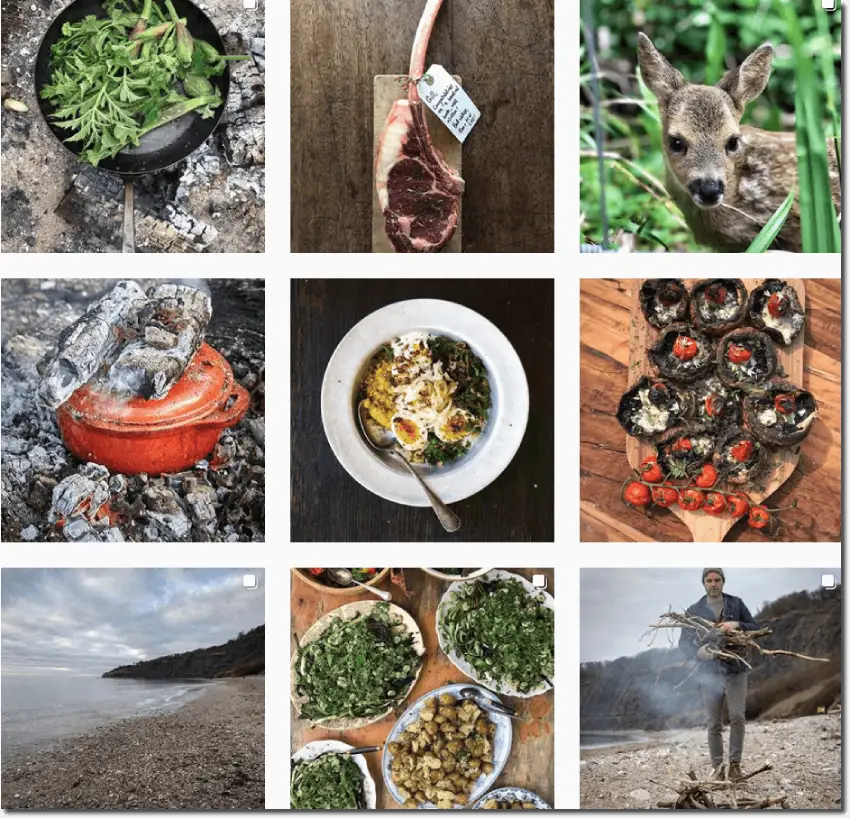
His “unique selling point” (USP) is that he cooks with local, seasonal, and even wild ingredients. And he uses those values in everything he does: creating restaurant menus, writing recipe books, and even posting on Instagram.
So what makes your book different? What’s your USP?
Foster a genuine community
Social media has been a real gift to authors, publishers, and marketers over the last few years. It enables you to connect with readers, around the world, almost as if you were having a face-to-face conversation.
But there is a flip side. Because social media makes real relationships possible, people are extra-sensitive to sales talk and inauthenticity. In other words: the hard sell doesn’t work.
Instead, you need to spend time building a genuine community. That means not just the readers who pay for your books, but also other chefs, other authors, and people who just want to see what you’re cooking up from day-to-day.
You don’t want to push your book right away; you want to lay off the foundation of trust so that people will choose your cookbook without being bullied into it.
BookBub has some great ideas for fostering a community in this blog. Try a few different networks and ideas, and see what sticks! Most of all, remember that every community is unique – just like your cookbook. You’ll soon learn what suits your followers, and what doesn’t.
Build your presence across social media
Part of growing your community is creating a recognizable brand. You want to use a consistent voice and style across all your social media channels.
Take a look at this example: Budget Bytes, a hugely popular food blog that’s produced multiple recipe books and even an app. Their Pinterest profile has an instantly recognizable style. Every photo post uses the same birds-eye-view angle, custom font, and bright colors.
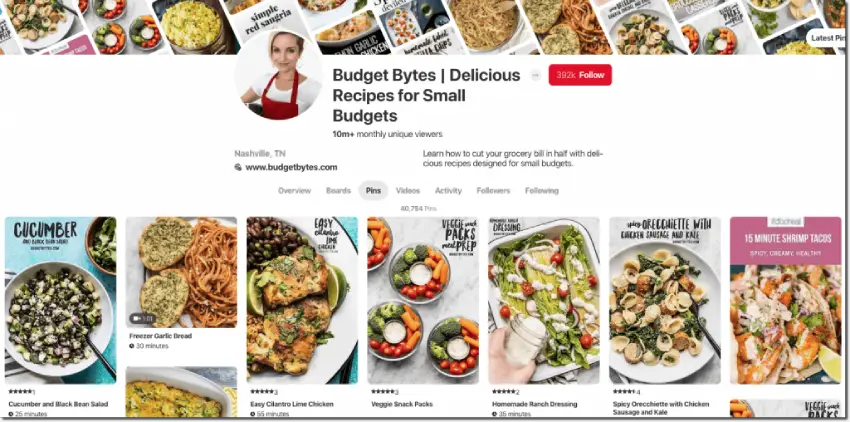
Even if you’re not a design expert, you can add this touch of class to your own posts. Spend some time playing around with a photo editing app, or pick out a color scheme for your social media posts.
Make sure you spread your presence across a few different social networks, too. While you don’t need to be on every single site, you don’t want to put all your eggs in one basket.
Start by connecting up your communities on different social networks: encourage people to follow you on all your accounts, or run a multi-network giveaway to unite Instagram, Facebook, and Twitter followers.
Adding people to your mailing list will also protect you from any sudden changes in social media algorithms. The glorious dessert blogger David Lebovitz has a list of food blog newsletters that are worth reading – and learning from.
Visit our blog post about book giveaways on social media for more tips, examples, and inspiration.
Have a regular posting schedule
Once you’re set up on a range of social networks, it’s time to get organized. Scheduling your content in advance is less stressful than posting minute-by-minute. What’s more, your followers will appreciate a feed of varied, reliable posts.
Plus: we can’t make any promises, but regular posts may help your profile get more traction. On some networks – especially Instagram – your viewing figures seem very closely linked to how often you post.
So what does variety look like? Once again, let’s take a peek at the experts. You’ve probably heard of Smitten Kitchen, another cult food blog that offers delicious, but achievable, recipes online.
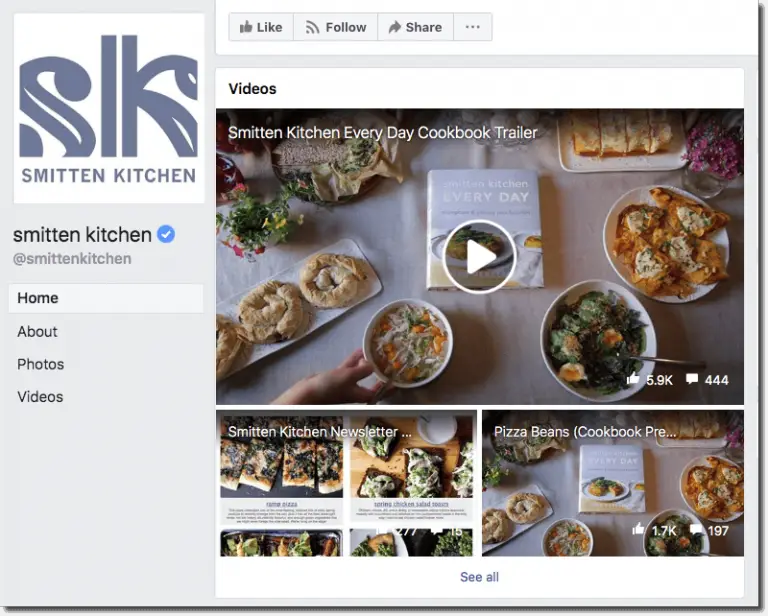
Their Facebook feed has a healthy mix of different content, from cookbook trailers to newsletters and teaser recipes. You’ll notice that all the posts above are videos: video content is more successful on Facebook than static posts.
If you’re getting tired of producing beautiful, finished shots, then don’t be afraid to share some photos from behind the scenes. This kind of content doesn’t have to be super polished – and your followers will absolutely love it.

Create a sensory experience
So far, we’ve talked a lot about authenticity. Having something unique to share with your readers. Creating a genuine community.
But there is one significant problem to overcome when you promote a cookbook on social media. Unfortunately – even with all the modern technology of 2019 – there’s no way to share a taste, smell, or texture online.
Food and cooking are deeply sensory experiences, covering the boundary between mental and physical enjoyment. So how do you translate that on to the screen?
Well, until WonkaVision becomes a reality, our best solution is video and photographs. You can use these to show texture and color, even if people can’t really taste the delicious snacks on screen.
This is another opportunity to define your brand, too. Let’s take a look at how some recipe blogs design their social media differently.
First up, we have Spoon Fork Bacon, a classic comfort food blog. Their Instagram feed is full of warm red and yellow tones. They make us feel all cozy inside, like a really good bowl of mac’n’cheese or an old-school apple pie.
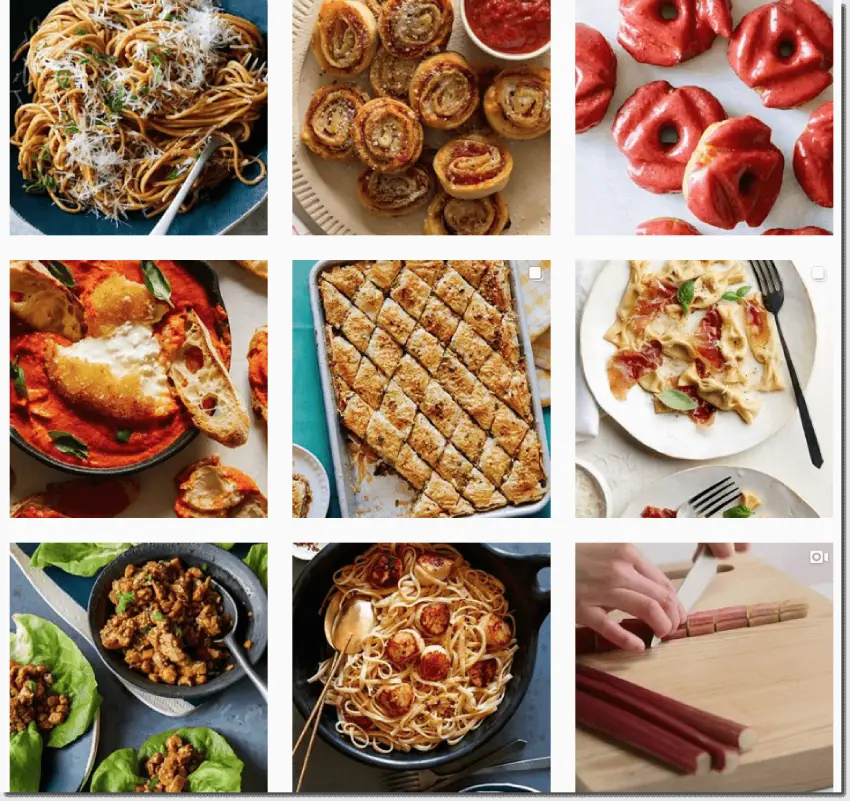
And now for the contrast: Sprouted Kitchen, a blog for “approachable, health-conscious recipes”. This Instagram page is packed with cool, almost sepia-toned photos. It’s minimalist. Pure. Focused on the bare ingredients.
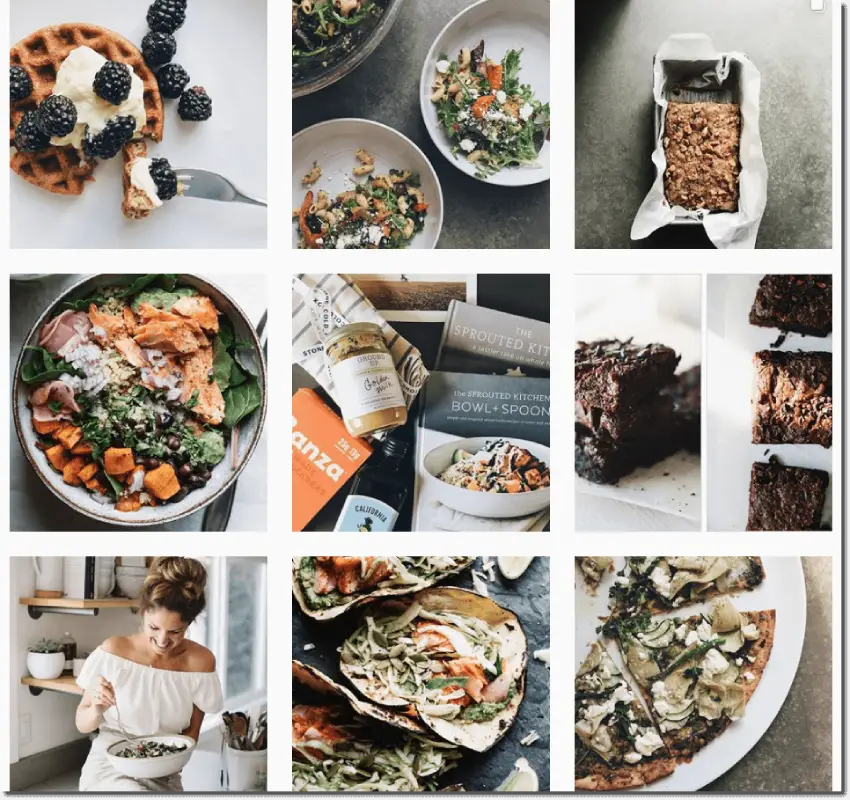
Video content will add another dimension to these photos, too. Use sound to evoke your recipes: the crunch of a fresh cookie, the sound of a spoon stirring a pan full of melting chocolate. Use photo and video captions to describe the taste of your food in loving detail. Don’t be afraid to get a little ~sensual~.
To sum up: Social media is cold, but the food is hot. Make people feel it!
Share teaser photos and recipes
OK, enough about general strategies on social media. What about the most important part: promoting your cookbook?
Let’s start with the run-up to your publishing date. You want to build the hype and show people what’s on offer – without giving away all the secrets you wrote in your recipe book. It’s a difficult balance to strike.
One method is to share teasers from your book. Start with something small – a fragment of a photo, a corner of the cover – and work up to bigger spoilers. In the last few weeks before the book is released, you can share teaser recipes to give people a taste of what’s to come.
You can be smart with how you share these recipes, too. If you don’t want to give away a recipe to everyone online – then don’t!
Offer exclusive recipes to people who sign up for your newsletter, or pre-order the book. Just make sure you announce those exclusives on social media, so that everyone else knows what they’re missing.
Run giveaways to increase followers and engagement
Another way to tease your recipe book is to give it away… but only a few copies!
Social media giveaways are very easy to set up. It’s as simple as making a post on Instagram, Facebook, Twitter or YouTube – then using an app to harvest the comments and pick a winner. You can even collect comments from several different social networks, with a multi-network giveaway app.
Of course, the main goal here is to get more attention and encourage sales from people who aren’t lucky enough to win a copy.
But you can also use giveaways as a tool to make your social media strategy more efficient. For example, you’ll get a ton of statistics from the giveaway about which social networks are most active, what time your followers are online, and so on. Use that info to time your next few posts!
You can also use the giveaway post itself to learn more about your readers. Remember, you want to pick a winner from the comments. So start a conversation by asking an engaging question. Here are a few ideas:
- What’s your favorite cookbook/recipe author?
- If you win a copy of the cookbook, who will you share the recipes with?
- What’s your go-to dinner party recipe?
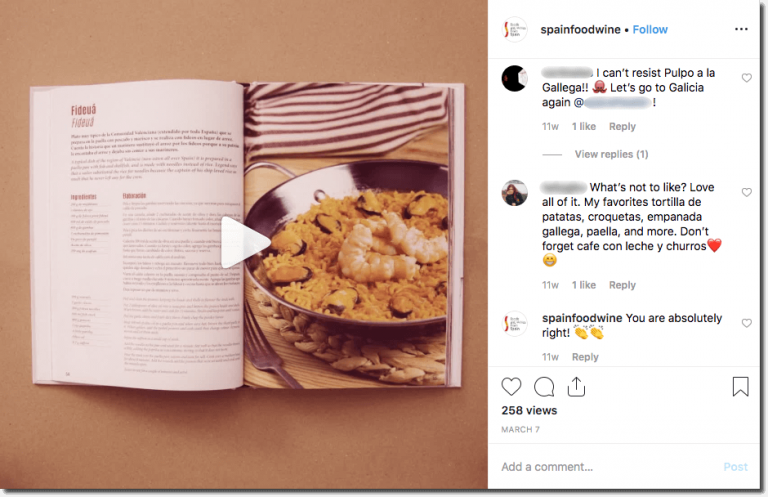
You can ask questions inspired by your own cookbook, of course. Like in the example above: it’s a Spanish recipe book, so they asked people to share their favorite dishes from Spanish cuisine.
Another popular way to run a giveaway is teaming up with a publisher, recipe blog, or other related business. You’ll double your audience by working with another person while spreading the cost and effort of the giveaway.
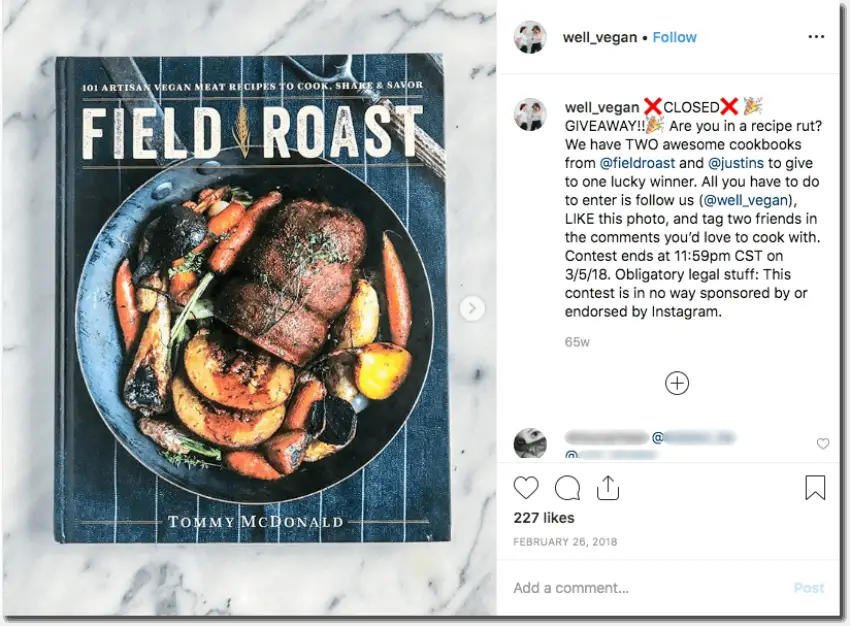
Interact with other authors and their recipes
Speaking of partnerships… Don’t forget that other authors are a part of your community, just like any other potential reader!
When you build up relationships with other recipe bloggers and writers, there are so many benefits.
You’ll gain all the advantages of professional networking, plus support and friendship from people who really understand how to write, publish, and then promote a recipe book on social media. You’ll also have the chance to get in touch with their readership, possibly expanding your own circle of readers.
And food writers really are a friendly bunch. Take a look on Instagram or Twitter: you’ll see chefs trying out each other’s recipes, sharing tips with readers, and just generally being upstanding members of the community.
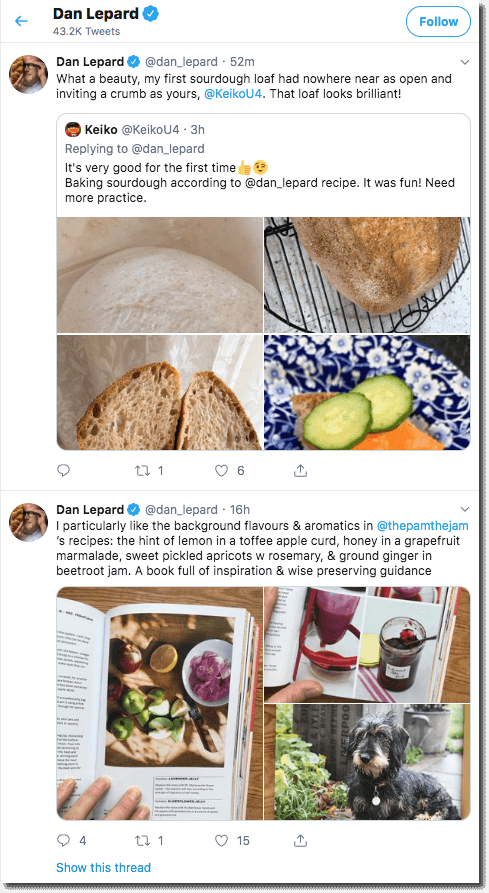
Of course, this should be a reciprocal process. Don’t expect anyone to go out of their way to promote your cookbook on social media if you’re not giving something back. Be active online, respond to questions and comments, and encourage other cooks. Everybody wins!
Post reviews, comments, and photos by your followers
Finally, let’s look ahead to when your book is released.
Congratulations! You did it! Now, if your social media has been up to scratch, you’ll soon have comments, reviews, and photos rolling in.
And it’s a good idea to share all that feedback you get. There are 2 good reasons why:
- This is what marketers call “social proof“. All those comments from real readers will persuade more people to buy your cookbook.
- Re-posting feedback encourages more reviews. If people know that you’ll comment and share their posts about your recipe book, then they’re more likely to share!
Not to mention that this is an essential part of interacting with your community. After all, you’ve spent months building a genuine following of people who love your work. And they don’t just disappear when your book comes out!
Instead, you want to continue that relationship with your readers as they try your recipes, share their experience… and get ready to buy your next masterpiece.
The finishing touch
So at the end of this article, what have we learnt? If you only remember 1 thing from all this advice, it should be this:
Be. Real.
Don’t just turn into a robot, tweeting the same purchase link to your cookbook over again! Be real with your readers. Share real content that you care about. Respond when people talk to you. Join a real community of other food writers.
The best way to promote a cookbook on social media is to be genuinely social. When your followers feel valued and supported, when you welcome them into your virtual kitchen to cook along with you, then they’ll be ready to invest in your recipe book.
Do you have questions that haven’t been covered in this blog post? Contact our Support Team, they’re always ready to assist and inspire!